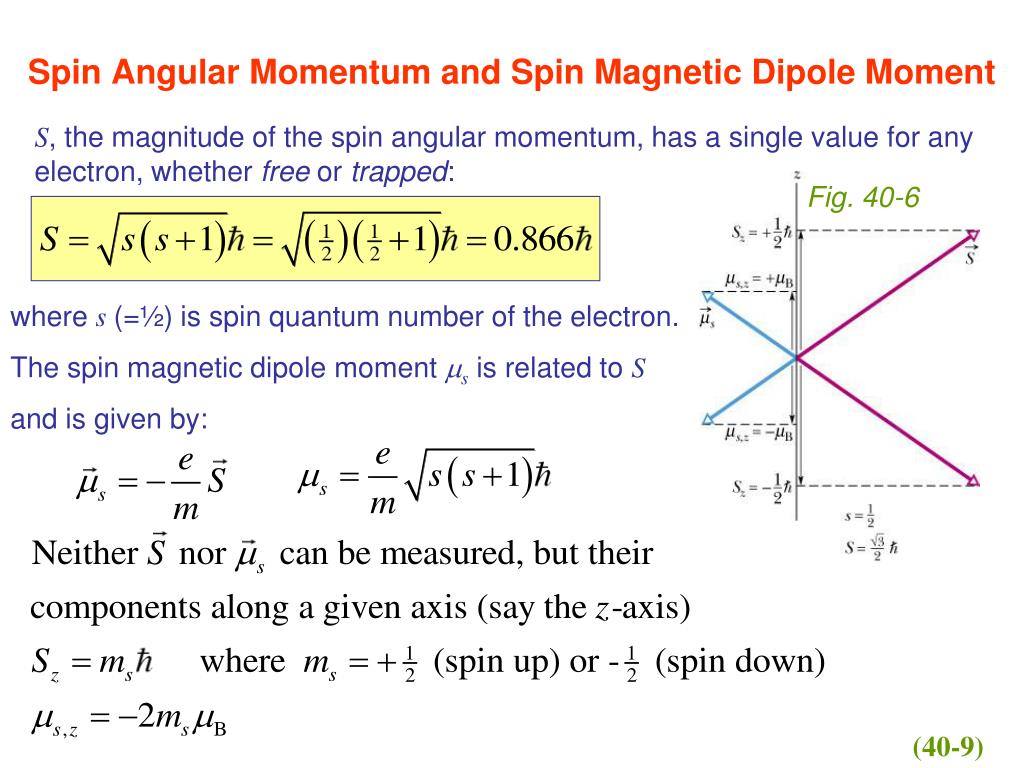Spin Angular Momentum
Broadly speaking, a classical extended object (e.g., the Earth) can possess two different types of angular momentum. The first type is due to the rotation of the object’s center of mass about some fixed external point (e.g., the Sun)—this is generally known as orbital angular momentum. The second type is due to the object’s internal motion—this is generally known as spin angular momentum (because, for a rigid object, the internal motion consists of spinning about an axis passing through the center of mass). By analogy, quantum particles can possess both orbital angular momentum due to their motion through space (see Chapter [sorb]), and spin angular momentum due to their internal motion. Actually, the analogy with classical extended objects is not entirely accurate, because electrons, for instance, are structureless point particles. In fact, in quantum mechanics, it is best to think of spin angular momentum as a kind of intrinsic angular momentum possessed by particles. It turns out that each type of elementary particle has a characteristic spin angular momentum, just as each type has a characteristic charge and mass.

- 9.1: Spin Operators
- Because spin is a type of angular momentum, it is reasonable to suppose that it possesses similar properties to orbital angular momentum. Thus, by analogy, we would expect to be able to define three operators that represent the three Cartesian components of spin angular momentum. Moreover, it is plausible that these operators possess analogous commutation relations to the three corresponding orbital angular momentum operators.
- 9.2: Spin Space
- Unlike regular wavefunctions, spin wavefunctions do not exist in real space. Likewise, the spin angular momentum operators cannot be represented as differential operators in real space. Instead, we need to think of spin wavefunctions as existing in an abstract (complex) vector space. The different members of this space correspond to the different internal configurations of the particle under investigation. Note that only the directions of our vectors have any physical significance.
- 9.3: Eigenstates of Sz and S²
- Because the operators Sz and S² commute, they must possess simultaneous eigenstates.
- 9.4: Pauli Representation
- Up to now, we have discussed spin space in rather abstract terms. In the following, we shall describe a particular representation of electron spin space due to Pauli . This so-called Pauli representation allows us to visualize spin space, and also facilitates calculations involving spin.
- 9.5: Spin Precession
- The expectation value of the spin angular momentum vector subtends a constant angle α with the z -axis, and precesses about this axis. This behavior is actually equivalent to that predicted by classical physics.
- 9.E: Spin Angular Momentum (Exercises)

Contributors and Attributions
Spin And Orbital Angular Momentum
Richard Fitzpatrick (Professor of Physics, The University of Texas at Austin)
( newcommand {ltapp} {stackrel {_{normalsize<}}{_{normalsize sim}}}) (newcommand {gtapp} {stackrel {_{normalsize>}}{_{normalsize sim}}}) (newcommand {btau}{mbox{boldmath$tau$}}) (newcommand {bmu}{mbox{boldmath$mu$}}) (newcommand {bsigma}{mbox{boldmath$sigma$}}) (newcommand {bOmega}{mbox{boldmath$Omega$}}) (newcommand {bomega}{mbox{boldmath$omega$}}) (newcommand {bepsilon}{mbox{boldmath$epsilon$}})
Angular Momentum For Kids
In quantum mechanics and particle physics, spin is an intrinsic form of angular momentum carried by elementary particles, composite particles (hadrons), and atomic nuclei. Spin is one of two types of angular momentum in quantum mechanics, the other being orbital angular momentum. In quantum mechanics and particle physics, spin is an intrinsic form of angular momentum carried by elementary particles, composite particles (hadrons), and atomic nuclei. Spin is one of two types of angular momentum in quantum mechanics, the other being orbital angular momentum. In addition to the orbital quantum numbers already introduced, the electron has a spin quantum number, m s = ½ or ‒ ½, distinguishing the orientation of the spin angular momentum – pointing up or down, respectively. There are two states associated with the lowest energy level: (n, ℓ, m ℓ. This intrinsic angular momentum is called spin angular momentum, or simply spin, since it is possible to picture it as being due to the electron spinning around its own axis. The spin angular momentum of the electron is fixed and a magnitude of ℏ√3 / 4, corresponding to a half-integer quantum number, s = 1 / 2.